Читать книгу Wake Up and Sell the Coffee! - Martyn Dawes - Страница 10
На сайте Литреса книга снята с продажи.
My mind turns to coffee
ОглавлениеI returned home thinking that coffee sold in takeaway cups was my idea and there were a number of positive trends I quickly picked up on:
Coffee and sandwich shops were expanding in the UK. Aroma and Seattle Coffee Company were making waves and Coffee Republic opened its first store in 1996.
One of these chains already had some concessions in Waterstones bookshops, so this gave me confidence in the idea of coffee being sold in locations other than standard cafes.
I discovered that fresh coffee was one of the most important elements of the American c-store product range.
I started to list the potential locations where takeaway hot drinks could be sold. I began with CTNs (confectioners, tobacconist, newsagents) and quickly decided that post offices, small grocery stores, opticians, doctor’s surgeries, chemists, tube stations and fashion stores could all be possible locations. If even a small fraction of these worked I’d be looking at thousands of locations.
Then I started to research the equipment and supply side of the model. I found a number of small table top beverage dispensers that were made in the UK, meaning it would be easy to deal with the manufacturers. These were also, I thought, a good price at less than £1000. They used instant coffee granules and powdered milk whisked together with water to produce a cappuccino-style drink.
I researched ingredient and consumable supply and met suppliers. I could produce a coffee for 4p and a cup, lid, sugar and stirrer were another 4.5p. Recognising that I wasn’t competing against coffee bars – this was a convenience product, not an indulgence – I set the drink price in my mind at 60p. Many of my friends would recall me asking them around that time: “Would you buy a coffee from a newsagent and what would you pay?” Simple market research indeed.
I envisaged the coffee dispenser sitting atop a small fabricated unit that would incorporate cups, lids and other consumables, and a bin for discarded sugar tubes and stirrers. I took some design cues from coffee bars. I remember newspaper articles from that time talking about this US import of drink-thru’ lids which were becoming popular in coffee bars, so I decided to use them as well.
One of the obvious ingredient suppliers for me to speak to was Nestlé, owners of the brand Nescafé. I figured that if I could use the world’s leading brand of instant coffee in the machine this would bring immediate credibility.
It turned out that Nestlé too recognised the development of a food-on-the-move culture in the UK and had an eye on the takeaway coffee market. I was soon meeting them in their head office tower in Croydon, South London. My revenue share business model appealed as they could see that by me owning the equipment and splitting the revenue with the retailer it opened up literally thousands of locations.
They were excited at the prospects of the Nescafé brand being able to penetrate this new market channel and quickly agreed to pay for point of sale material and in-store signage for each location. They also agreed to pay for each machine to be Nescafé branded. This was a real coup for me; all this marketing support at zero cost. I also negotiated great rates for the coffee prices. Nestlé had other brands in petrol station forecourts in central London and we went on a tour of those together. I figured I could learn a lot from these guys.
Despite my comfort with my own business model of selling instant coffee in small shops, I do recall thinking that perhaps Nestlé were being naive in not recognising the growth of roast and ground coffee, which was fuelling the growth of the new breed of coffee bars. This didn’t cause me much concern, however, as I felt people would not be prepared to pay the price for ground coffee in a corner shop or petrol forecourt.
